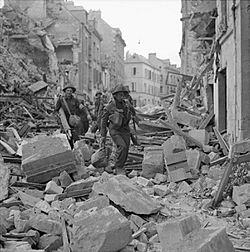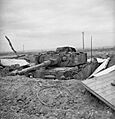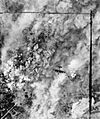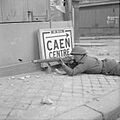Operation Charnwood facts for kids
Quick facts for kids Operation Charnwood |
|||||||
|---|---|---|---|---|---|---|---|
| Part of the Battle for Caen | |||||||
 British troops of I Corps pick their way through the rubble of Caen, 9 July 1944 |
|||||||
|
|||||||
| Belligerents | |||||||
| Commanders and leaders | |||||||
|
|
||||||
| Strength | |||||||
|
|
||||||
| Casualties and losses | |||||||
|
|
||||||
| 300–400 French civilian casualties | |||||||
Operation Charnwood was a big attack by British and Canadian forces during World War II. It happened on July 8–9, 1944. This operation was part of the larger Battle for Caen, which was itself part of Operation Overlord (the code name for the Battle of Normandy).
The main goal of Operation Charnwood was to capture the city of Caen in France. German soldiers had control of Caen. The Allies (Britain, Canada, and their friends) really wanted Caen. It was an important city for their plans after the D-Day invasion. They also hoped this attack would stop German tank units from moving to another part of the battle where American forces were getting ready to attack.
Before the ground attack, many bombs were dropped on Caen. This bombing destroyed a lot of the old city. On July 8, three infantry divisions, supported by tanks, attacked German positions north of Caen. They slowly pushed back the German 12th SS Panzer Division and the 16th Luftwaffe Field Division. By the end of the first day, the British and Canadian soldiers had cleared nearby villages and reached the edge of Caen.
The next morning, July 9, the Allies moved into Caen. They met some German resistance, but many German units were already starting to pull back. The Canadians captured Carpiquet airfield early that morning. By the evening, British and Canadian troops had met up along the north side of the Orne River. The bridges over the river were either blocked or guarded by Germans. Since German reserves were waiting on the other side, the Allies stopped their attack.
Operation Charnwood was a success for the Allies, but both sides lost many soldiers. The Germans moved away from the north side of the Orne River. However, they still sent some forces to fight the Americans. The Germans then set up new defenses south of Caen. The Allies kept up the pressure. They launched Operation Jupiter the very next day. A week later, Operation Goodwood and Operation Atlantic helped them secure the rest of Caen.
Contents
Why Caen Was Important: The Background of the Battle
The city of Caen was a key target for the British 3rd Infantry Division on D-Day, June 6, 1944. Capturing Caen was a very important goal for the British I Corps.
The original plan for Operation Overlord was for the British Second Army to take Caen. Then, they would create a strong defensive line. This line would help protect the American forces as they moved towards Cherbourg. Controlling Caen and the areas around it would also give the Second Army a good starting point to push south towards Falaise. The land between Caen and Vimont was flat and dry. This made it perfect for fast attacks with tanks. Since the Allies had many more tanks than the Germans, this kind of battle was good for them.
However, the 3rd Infantry Division faced problems on D-Day. They had trouble getting off the beaches. Their tank support arrived late. Because of this, they couldn't attack Caen with enough strength. Later attacks also failed as the Germans brought in more soldiers, especially the 12th SS Panzer Division.
On June 7, the British started Operation Perch. This was a plan to surround Caen from both the east and west. But the German 21st Panzer Division stopped the attack east of Caen. The Panzer-Lehr Division also stopped the attack west of Caen. The British tried another attack called Operation Epsom on June 26. This attack aimed to go west of Caen and cross the Odon and Orne rivers. The Germans stopped this attack too. They used all their available forces, including two SS Panzer Divisions that had just arrived from the Eastern Front.
On June 27, the British 3rd Infantry Division launched Operation Mitten. Their goal was to capture two German-held castles. The first attack failed, but the next morning, they succeeded. This area was later called the "bloodiest square mile in Normandy."
German leaders had different ideas about defending Caen. One commander, Gerd von Rundstedt, wanted to slowly give up Caen and move tanks to fight the Americans. But Adolf Hitler disagreed. He believed Caen was vital for defending Normandy. Hitler then replaced Rundstedt with another commander. The Allies found out about this through secret intelligence. This made the Allied commander, Bernard Montgomery, plan a new attack to take Caen. He also wanted to stop the Germans from moving their forces to the American front.
On July 4, the 3rd Canadian Infantry Division launched Operation Windsor. They tried to capture Carpiquet and its airfield from the 12th SS Panzer Division. Carpiquet village fell on July 5, but the airfield remained in German hands.
Getting Ready for Battle: Operation Charnwood Plans
Since earlier attempts to take Caen didn't work, General Montgomery decided to attack the city head-on. Even though Caen's importance had changed since D-Day, he still wanted to control the high ground south of the city. On July 5, the orders for Operation Charnwood were given. The attack would start at 4:20 AM on July 8.
Allied Strategy: How the Allies Planned to Attack
The goal of Charnwood was to clear German soldiers from Caen up to the Orne River. If possible, they also wanted to cross the river and set up positions on the south side. The plan was to send tanks through the city to quickly capture the bridges. This would allow the British Second Army to push further south towards Falaise. However, some historians believe the operation was only meant to clear the city. They thought it would be impossible to quickly move through and beyond Caen because of the river and a canal.
British I Corps, with 115,000 soldiers, was given the job of reaching the Orne and Odon rivers. The 3rd Infantry Division would attack from the northeast. The 59th (Staffordshire) Infantry Division would attack from the north. The 3rd Canadian Infantry Division would attack from the northwest. Each division would have tank support. To keep pressure on the Germans, another British corps, VIII Corps, was ready to launch attacks west of Caen.
The Allies learned from earlier battles. They decided to attack on a wide front to spread out the German defenses. They also decided to use air power. RAF Bomber Command would drop heavy bombs on Caen the night before the attack. Some bombs were set to explode later, when the ground attack began. Light bombers and American bombers would follow.
Other support would come from rocket-firing Typhoon planes, naval ships, and big guns from a battleship. In total, 656 artillery guns would fire at German positions. The plan was to drop 2,000 tons of bombs on Caen before the soldiers moved in. Because the bombing target was close to Allied lines, the bombers aimed a bit further south. This meant many bombs fell on Caen itself, away from the main German defenses. After the bombing, the three infantry divisions would push through fortified villages and move directly into Caen's northern areas.
German Defenses: How Germany Prepared for the Attack
Caen was defended by two German divisions: the 12th SS Panzer Division and the 16th Luftwaffe Field Division. The Germans expected an attack on the city. The 12th SS Panzer Division, with 61 tanks, was defending the northwest approaches to Caen. They were protecting the city and Carpiquet airfield from the Canadians and British.
The main German defense line was a 9-kilometer (5.6-mile) arc of villages. These villages were held by soldiers from the 12th SS Panzer Division. They had strongpoints with tanks, anti-tank ditches, minefields, and other obstacles. The rest of the division's tanks were kept in reserve. Most of their artillery had been moved across the Orne River.
The 16th Luftwaffe Field Division was an inexperienced infantry division. They had just arrived in Normandy. They didn't have enough anti-tank weapons, so they were given a tank battalion from another division. This Luftwaffe division was positioned on both sides of the Orne River. Another SS Panzer Division was about 5 kilometers (3.1 miles) south of Caen.
The Bombing of Caen: July 7 Air Attack
On the night of July 7, 467 British bombers attacked Caen. They dropped over 2,000 tons of bombs on the city. The bombing was meant to help the Anglo-Canadian advance. It also aimed to stop German reinforcements from reaching the battle or retreating through Caen. However, the bombing mostly failed to destroy the main German tank and infantry positions north of Caen. Only two German tanks were destroyed.
General Miles Dempsey, who commanded the British Second Army, was more interested in how the bombing would make his own troops feel. He thought it would boost their morale. Many of the bombs fell too far into Caen itself, away from the German defenses. By 10:00 PM on July 7, the bombers had left. About 80 percent of northern Caen was destroyed. Caen University was hit hard, causing chemical fires. Ten minutes later, 636 artillery guns opened fire, with support from a battleship and other ships. This heavy shelling aimed to destroy German strong points before the infantry attack.
The Battle for Caen: July 8 and 9
The First Day: July 8 Advance
At 4:30 AM on July 8, the artillery shifted its fire deeper into the German defenses. As the infantry and tanks moved forward, the shelling slowly moved ahead of them. At 7:00 AM, American bombers arrived. But clouds covered the battlefield, so only some planes could drop their bombs. Some bombs even landed near the German headquarters.
The British and Canadian divisions faced different levels of resistance. On the right, the Germans still held high ground around Carpiquet airfield. On the left, the British 3rd Infantry Division made good progress against the weaker 16th Luftwaffe Field Division. They quickly pushed through Lébisey. However, fighting became harder as they reached Hérouville. The German commander, General Heinrich Eberbach, tried to move the 21st Panzer Division to help. But the Allies spotted this move. When the German tanks tried to cross the Caen Canal, naval ships fired at them, forcing them to stop.
In the center, the British 59th Division faced much stronger resistance from the 12th SS Panzer Regiment. Further west, the 3rd Canadian Division fought hard in Buron. Buron was defended by 200 men from the 12th SS. With tank support, the Canadians took Buron by noon, but they lost many soldiers. South of Buron, German tanks counter-attacked. But British anti-tank guns destroyed 13 German tanks. This was one of the most successful anti-tank battles of the campaign.
Gruchy was captured more easily. The 7th Canadian Infantry Brigade pushed towards Authie. The capture of Authie helped the 59th Infantry Division attack St-Contest, which also fell. This cleared the way for an advance on Caen. Later, the 7th Brigade captured the former headquarters of the 12th SS Panzer Division at Ardenne Abbey.
The British 3rd Division pushed past the 16th Luftwaffe Division and reached the edge of Caen from the northeast. By 7:15 PM, German commanders allowed the 12th SS Panzer Division to pull back their heavy weapons across the Orne River. The 12th SS fought a rearguard action, slowing down the British and Canadians as they retreated. Allied patrols thought the Germans were not withdrawing, which was a false idea.
The Second Day: July 9 Capture of Caen
British and Canadian patrols began to enter Caen at dawn on July 9. The Carpiquet airfield finally fell to the Allies early that morning. The 3rd Canadian Infantry Division found that the German 26th SS Panzergrenadier Regiment had left during the night. As the German situation north of the river became very difficult, the remaining German units slowly pulled back across the Orne River. They moved towards the Verrières and Bourguébus Ridges.
By noon, the British 3rd Infantry Division had reached the north bank of the Orne. They had almost completely destroyed the parts of the 16th Luftwaffe Field Division that were west of the Orne. A few hours later, the British and Canadians met in the center of the city. By 6:00 PM, the northern half of Caen was firmly under Allied control. All the goals of I Corps had been met.
Some of Caen's bridges were still standing, but they were either blocked by rubble or defended by German soldiers on the south bank. The 1st SS Panzer Division had also taken positions to stop any further Allied advance.
The 12th SS Panzer Division, which had very few infantry soldiers left, claimed to have destroyed 103 British and Canadian tanks during the two-day battle, while losing 20 of their own. When the Anglo-Canadian troops entered Caen, they found it in ruins. Four-fifths of the old city was destroyed by the July 7 bombings. The debris in the streets made it almost impossible for British tanks to move through the northern part of the city. This stopped the Second Army from pushing further. Without controlling the land south of the city, no more gains could be made inside Caen. So, by mid-afternoon on July 9, Operation Charnwood was over.
What Happened Next: Aftermath of Charnwood
Recognizing the Soldiers: Battle Honours
The British and Commonwealth system of battle honours recognizes important battles. For fighting in Caen between July 4–18, 1944, 55 military units were given the honor Caen. For taking part in Operation Charnwood itself, between July 8–9, some units received special honors like Orne, The Orne, and The Orne (Buron).
The Bombing's Impact: What We Learned
Many people later called the bombing of Caen "one of the most pointless air attacks of the war." Some historians said it was a "disaster" and "pathetic." They also said the bombing made it harder for the Allies to enter the city. A survey after the battle found that no military targets of value had been hit. There were no German guns, tanks, or dead soldiers in the main bombed area. Soldiers from the 3rd Infantry Division were confused about why the bombers were used.
However, the historian for the 3rd Division wrote that after the air raid, the soldiers "breathed freely" and felt "encouraged" by the air support. The Canadian Official Historian also wrote that many Canadian units felt their morale increase. Some believed the bombing was important because it boosted Allied morale and lowered German morale. An intelligence report based on questioning German prisoners said the raid was "decisive." It seemed to have destroyed a German headquarters and cut off supplies for German troops north of Caen.
Other reports concluded that the bombing itself didn't help much with the ground attack. They suggested using bombs that exploded instantly and following up bombardments immediately with ground forces. This would take advantage of the main effect of bombing, which was to temporarily make the Germans less willing to fight. In later operations, the Allies did a better job of following up strategic bomber attacks right away.
Initially, the British said about 6,000 civilians were killed in the air raid. But it was later found that 300–400 civilians died. The people of Caen were very relieved when the Allies arrived. They gave their liberators a warm welcome. French accounts say that "All [of] Caen was in the streets to greet them." The Canadian historian noted that the people were especially happy to be freed by Canadian soldiers.
Next Steps: Subsequent Operations
Operation Jupiter: The Fight for Hill 112
On July 10, the 43rd (Wessex) Infantry Division attacked German positions southwest of Caen, specifically Hill 112. This attack was meant to threaten Caen from the west and push back the German 10th SS Panzer Division. It would also open a path for future attacks. Before the assault, there was a two-day bombardment with naval ships and planes.
The 43rd Wessex Division began their attack at dawn on July 10, with tank support. By 8:00 AM, British tanks and infantry were fighting the 10th SS Panzer Division on the slopes of Hill 112. Eterville was captured around mid-morning. The German commander insisted that "Hill 112 is the pivotal point... and must therefore be held."
German tank battalions and the 1st SS Panzer Division were sent to defend the hill. The British tanks reached the top, but German forces counter-attacked that evening. The British attack continued the next day. Hill 112 was briefly taken by a British battalion, but then lost again to German counter-attacks. By the evening of July 11, both sides were exhausted and had suffered heavy losses. The fighting had reached a stalemate. The 43rd (Wessex) Infantry Division and its supporting tanks had over two thousand casualties in just two days.
Images for kids
-
Men of the 2nd Battalion, Royal Warwickshire Regiment, of the 185th Brigade of the 3rd Infantry Division, advancing through a wheat field during the final assault on Caen.









